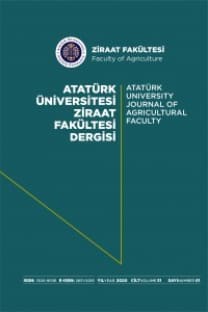VARYANS ANALİZİNİN FARAZİYELERİ VE BUNLARIN BOZULMASıNDAN DOĞAN DURUMLAR
ÖZETVaryans analizi, müşahedelerin şans değişkenlerinin bir denemedegerçekleşmiş değerleri oluşu, tesiri kontrol edilebilen faktörler vedeneme hataslnın toplanabilirfiği, şans unsurlarının bağımsızlığı,eşit. varyanslılığı ve normal dağııış giistermeleri faraziyelerine dayanır.Bunlardan biri veya birkaçının bozulması, sonuçların güvenirli/iğin ibozar. Durum, bazı müşahedelerin ihmali, hata varyansının parçalanması,serbestiik derecelerinde bir takım düzeltf!leler, bazı özel analizmetodlan yahut sağlam test/erin kullanılışı ve milşahedelerin transformasyonuile düzeltilebilir. Denememizde çarpımlı bir modelesahip lognormal dağılış ve yanlış model seçimi ile ortaya çıkan durum,normallik faraziye,sine uymayan Poisson dağılışı gibi faraziyelerdekişartları taşımayan durumlar ele alınmış ortaya çıkan aksaklıklarave düzeltici tedbirlere işaret edilmiştir.THE ASSUMPTIONS UNDERLYING THE ANALYSIS OF VARIANCEAND CONSEQUENCES OF DEPARTURES FROM THEM.The purpose of this study was to<leseribe the assumptions underıyingthe analysis of ~ariance and ındicatethe effects of d~partures from theseassumptions. Some 'methods to improvethe anaIysis weıe mentioned.The analysis of variance is usedmainly to estimate fixed effects oftreatments (Model-I) or to estimate~ome components of variance in acomposite population (Model-II). Ineither case, the assumptions requiredfor validüy of inferences are as follows:i) The observations must respresenta ranclom variable, .2) The treatment effects, the environmentaleffects and experimentalerrors must be additive,3) The experimental errors mustbe independent and have equal varianres,, 4) The observations must be nor-'.mally distributed.The consequences of departuresfr~m these ussumptions invalitades thefinaI results obtained by an analysisof variance. The effects depend on the'special as.sumptions and to the extentto, which these are violated.-Same commonIy used methods tomake the analysis nior~ valid in thecase of vioIation of assumptions are :1- Omission of some observations,2- Subdivision ofthe error variance,3- Some adjustments in the degreesof freedam,4- Use of some refined techniquestaking into account the violations(e.g. assignment of one degree of·freedomfor nonaddivtivity, ~liminatioİlof the correIation between errors byan analysis of covanance),5· Applicati?n of robust procedures,6- Change of scale.In order to demonstrate the effectsof departures from the aSsumptions,three Monte-Carlo sampling experimentswere Jperformed. The reslilts are asfollows :1) Nonadditivity of componen·s:For this purpose 1) muItiplicative modelis adopted. The ıesulting data are comingfrom a Lognormal distribution. Themultiple comparsion oftreatmeDt meansgives too many significant resuıts faılarge means, whereas the significantdifferences between small valued ,meansare ffidslred. Here, nonadditivity is'accompained by the heterogenity oferrors and' nonnorınality.. By taking 10gaıithmsone can improve the results.2) Nonormality: A comp~etely ran·domised experiment is siniuIated, theobservations having a Poisson distribution.As in the Lognormal distributionthe 'multiple comparison betweentreatment means gives misleadingresults in raw data. This impIies thatboth types of error are increased in thecase of Poisson distribution.3). Choosing a wrong model: Thedata are siınulatecl from an Ilxll Latinsquare .experim(1ot and analysed by. usİng the correct model or r21ndomisedblocks by choosİng rows and columnsas blocks, and by cömpletely randomiseddesign. The omission of some sources otvariation leads to exaggeration 6t errorvariance, ultimately causes loss of information.The signifiance of some differencesof means are lost by using a wrongdesign. in practice the violation maybe more serious, because in reducing theexperimentaI design, theıe is a great pro·bability that the factor omitted will faUnonorthogonal to the remainings.
Anahtar Kelimeler:
-
- ISSN: 1300-9036
- Yayın Aralığı: Yılda 3 Sayı
- Yayıncı: AVES Yayıncılık
